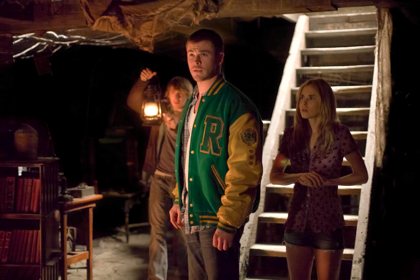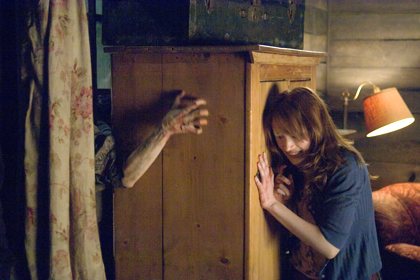Primary navigation


Drew Goddard and producer Joss Whedon’s marvellous meta-monster horror may be smarter (and funnier) than it is scary, says Kim Newman
Spoiler alert: this review gives away a major plot twist
When Boris Karloff hesitated during the filming of the sequence in Frankenstein (1931) where the Monster accidentally drowns the little girl, director James Whale persuaded him to go on by arguing that the sacrifice of an innocent was ‘part of the ritual’. Director Drew Goddard and producer Joss Whedon, who co-scripted The Cabin in the Woods, have spun this stray thought into an entire movie, taking the self-awareness of the Scream franchise even further into postmodernism by positing a world preserved from primal chaos only by a series of ritual sacrifices that take the form of horror movies. These sacrifices are masterminded by a clandestine global organisation, whose latest project involves a group of five young friends spending a weekend in an isolated cabin.
An amusing running joke keeps the film abreast of the Japanese arm of the organisation, which is having a gaggle of Kyoto schoolgirls terrorised by a floating ghost who is ultimately exorcised by being confined to the body of a happy frog, while monitors show the aftermaths of similar projects around the world as evil lairs burn down or giant apes lie dead in ruins. This is the most monster-happy movie since Anthony Hickox’s Waxwork (1988) and Waxwork II: Lost in Time (1992), and similarly finds a climactic excuse to unleash a horde of every imaginable menace on the labcoats who have supervised the project: a bat-vampire, killer robots, a knock-off of the Cenobites from Hellraiser, a giant snake, a werewolf, zombies, a killer tree, a giant spider, a disturbing ballerina with a tooth-ringed maw for a face, and a Lovecraftian/Creature from the Black Lagoon-ish merman. Also amusing is the moment when each of the kids in the cabin finds an object in the basement that might summon a specific monster, tipping this into a different subgenre of body-count horror picture, before a Latin passage in the diary turns it into a zombie/torture-porn hybrid.

The twist the film brings to its deliberately generic scenario – the title evokes The Evil Dead (1981) but also a whole host of lesser horror films – is the peek behind the curtain into the everyday control room of a malign universe which allows, indeed requires, that the young not only be sacrificed but exploited and stereotyped along the way. The most disturbing undercurrent to the banter is the way the kids sometimes sense that they’re being made to act out of character (fulfilling archetypal functions as ‘the Whore’, ‘the Fool’, etc) – thus sociology major Curt (Chris Hemsworth) becomes a dumb jock, and his girlfriend is prompted to be more sexually aggressive by a secret ingredient in blonde hair dye. By pulling back regularly, so that we see the technicians prematurely celebrating while the ‘final girl’ is still being battered by the zombie patriarch, or the crowds of looky-loos turning up for the supporting girl’s gratuitous nude scene, Cabin in the Wood has a lot of fun with the conventions of straight-ahead schlock.
If this wholly engaging and ingenious film has a problem, it’s the not unfamiliar postmodern glitch of being too clever by half. Goddard and a solidly likeable cast could probably make a horror picture that delivers fun and shocks as Sam Raimi did in the Evil Dead movies, but the tricksy approach requires the film to keep cutting away from suspense-building scenes in the woods to the commentary back in the control room, while the script springs surprise reversals that work like jokes rather than scares. For a film about a world on the edge of an abyss, this is a little too flip – evoking H.P. Lovecraft and Clive Barker but not really trying for their sense of cosmic dread and awe.
Women on Film inspirations: film characters: our competition entrants on The Final Girl (July 2011)
Mothra remembered by Kim Newman (September 2010)
Messiah of Evil reviewed by Tim Lucas (January 2010)
Scream 3 reviewed by Kim Newman (May 2000)
The cage of reason: Kim Newman on Tim Burton’s Sleepy Hollow (January 2000)
Gods and monsters reviewed by Kevin Jackson (April 1999)